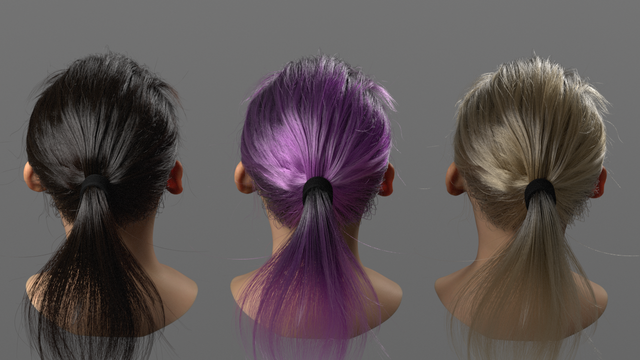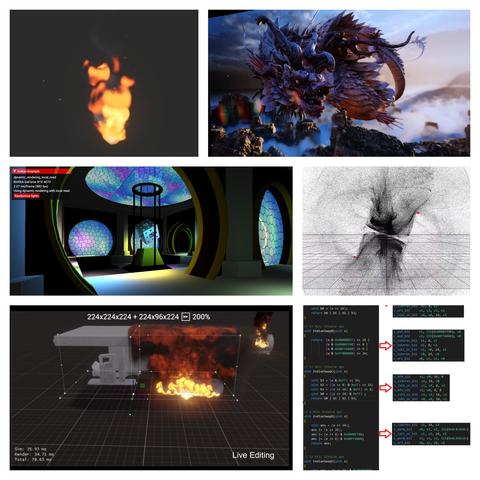@c0de517e Is this also on bluesky btw? Otherwise I'm going to broadcast this over there. :)
Lecturer @ Breda University. Real-time ray tracing, software optimization, GPGPU.
@c0de517e I do have a zip with the ompf2 database. If you want to revive it I can send it to you. :) Ompf sadly disappeared overnight with our benevolent leader and was lost afaik.
FrankenOMPF(/2) lives! https://c0de517e.com/EXTERNAL/ompf/index_main.htm and https://c0de517e.com/EXTERNAL/ompf2/index_main.htm - no link yet directly from my blog home, but... have fun!?
Code is now up. Would love some comments on the interface / implementation, see issue #83 :
https://github.com/jbikker/tinybvh/issues/83
What's up with the bunnies? They consist of spheres. :) You can now combine triangles, custom geometry, and multiple BVH layouts all in one TLAS, in both single and double precision. This does not affect perf of the default path (i.e. triangles only scenes).
Soon on the dev branch of tionybvh: https://github.com/jbikker/tinybvh/tree/dev
Highlighting one of the key contributions in MaterialX v1.39.2, Masuo Suzuki at NVIDIA contributed the Chiang Hair BSDF, seen below in NVIDIA RTX, which opens the door to the authoring of cross-platform, customizable hair shading models in MaterialX and OpenUSD.
https://github.com/AcademySoftwareFoundation/MaterialX/releases/tag/v1.39.2
Graphics Programming weekly - Issue 375 - January 19th, 2025 https://www.jendrikillner.com/post/graphics-programming-weekly-issue-375/
Ke-Sen Huang has the first batch of EGSR'24 papers:
https://realtimerendering.com/kesen/egsr2024-Changelog.htm
Looking good:
Bridge Sampling for Connections via Multiple Scattering Events by Schüßler et al., and
ReSTIR FG: Real-Time Reservoir Resampled Photon Final Gathering (repo).
What is the correct FOV to use in a game?
Think of your monitor as a window. Lines from your eye to the monitor (in the real world) should continue in the same direction in the virtual world.
You get this by taking the angle between the two solid lines: This is the correct FOV.
The default field of view in Starfield is 85. This may be correct, depending on how large your monitor is, and how close you are to it.
Helldivers 2 uses a vertical FOV of 55: roughly 85 vertically on a 16:9 monitor.
The #thisisigad C/C++ TMPL8 has been updated to 2024, with better OpenCL support, a 3D scene graph (via @syoyo's tinygltf/obj).
And: Several examples, many of which my (former) students will recognize. :)
repo: https://github.com/jbikker/tmpl8
Looking forward to '24/'25 at
BUas!
Our @BuasGames Y1 students did a remake of Will Wright's retro game 'Raid on Bungeling Bay', famous on #C64, NES and #MSX. How did they do?
Play it on http://itch.io: https://buas.itch.io/team-ginger
As paper co-chair for the High Performance Graphics conference (together with AMD's @AaronKnoll1) I am incredibly proud to announce that the paper line-up is now officially available on the HPG'24 website:
Updated: bvh_article source repo, at:
https://github.com/jbikker/bvh_article
Now with full OpenCL 3.0 support.
This takes you from basic CPU-side triangle intersection to real-time CPU ray tracing, and via basic GPU OpenCL first-hit to massive TLAS/BLAS. My poor UHD620. :)
Matching blog posts: https://jacco.ompf2.com/2022/06/15/how-to-build-a-bvh-part-9b-massive/
@sebastianlague has an excellent video up showing the impact of BVH (including SAH) on ray tracing performance. Good stuff.
https://youtube.com/watch?v=C1H4zIiCOaI
And thanks for the references to the BVH tutorial on my blog! https://jacco.ompf2.com/2022/04/13/how-to-build-a-bvh-part-1-basics/
I'm implementing a neural network from scratch in Dx12 (which learns to reproduce 2D image from UV coordinates) and the results are looking promising :) This is a lot of fun!
I've posted another Tangent Space Compression ShaderToy https://www.shadertoy.com/view/M3G3RR which also includes an improved QTangent encoding in four bytes (32-bits), 2x10bit + 9bit for the 3 smaller components of the quaternion and 1bit for
bitangent sign and 2bit for the largest component.
@c_discussions Looks like most of the math on that page is not rendering correctly?
Implementing General Relativity: Rendering the Schwarzschild black hole, in C++
https://20k.github.io/c++/2024/05/31/schwarzschild.html
Discussions: https://discu.eu/q/https://20k.github.io/c%2B%2B/2024/05/31/schwarzschild.html
Good explanation of the Riemann sum. ;) Thanks Justin Kujawa for sharing it with me!
To see it applied to computer graphics, see this article on the topic: https://jacco.ompf2.com/2019/12/11/probability-theory-for-physically-based-rendering/
@gob I think the people at Traverse Research did something like that:
https://blog.traverseresearch.nl/bindless-rendering-setup-afeb678d77fc

